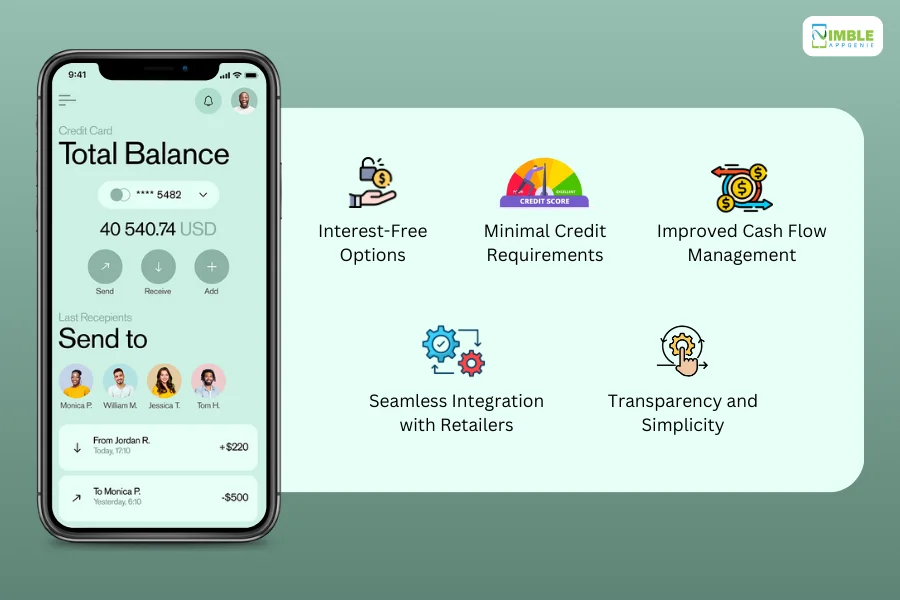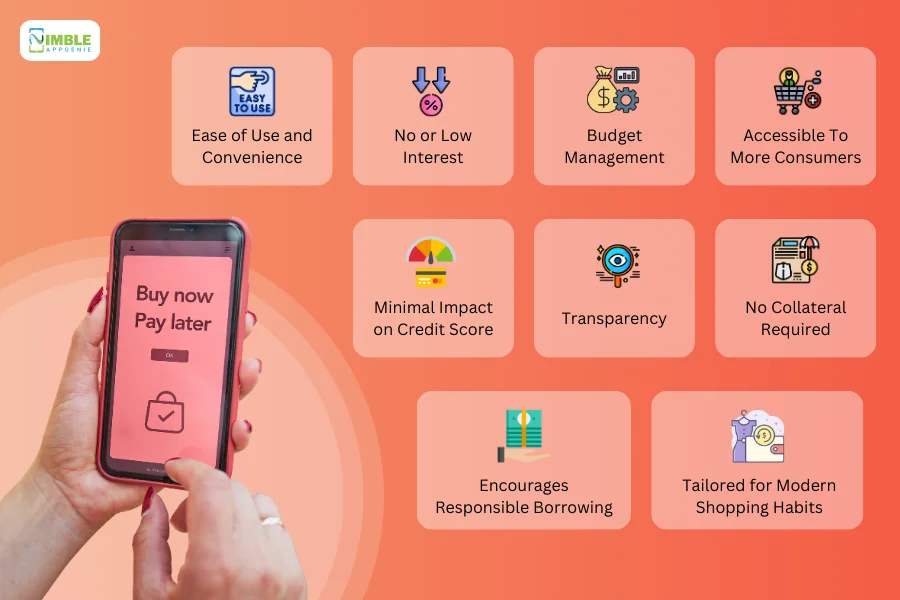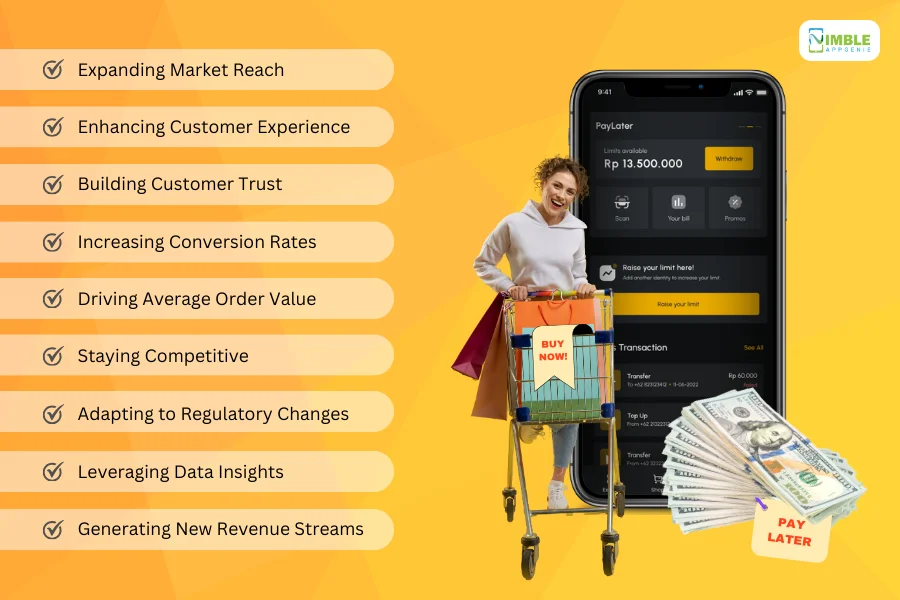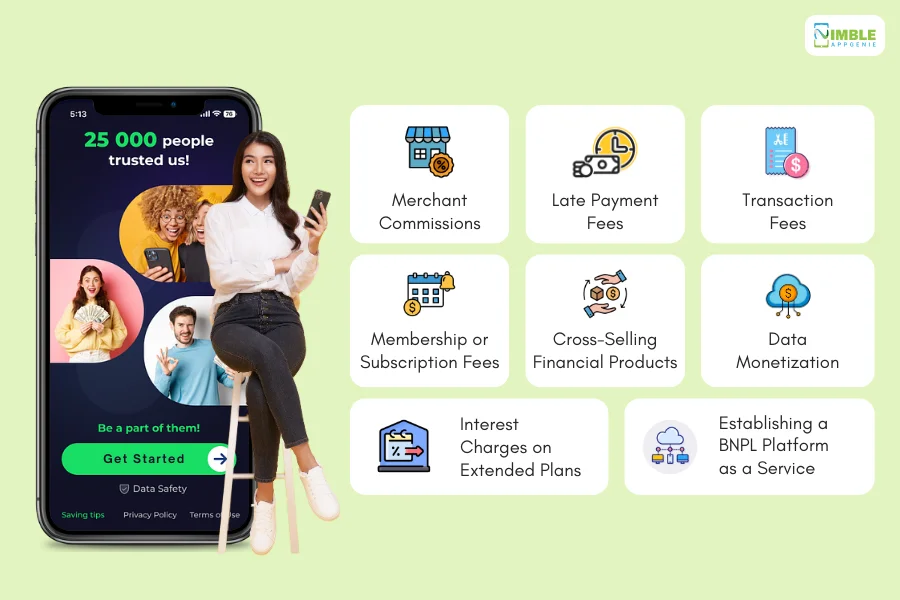BNPL or Buy Now Pay Later as growing super popular among fintech users.
But what is BNPL and how does it compare to traditional lending methods like Credit Cards, Loans, or EMIs?
Well, we shall be answering that and everything else related to that in this blog. Here we shall go through why BNPL apps are so popular and how do they compare to other financial products.
Plus, we shall also look at it from a business POV.
Therefore, with this being said, let’s get started with the very basics, that is…
Understanding Buy Now Pay Later Apps
So, what are BNPL apps?
The Buy Now, Pay Later or BNPL apps refer to fintech products that let users lend small loans for online purchases.
These solutions have revolutionized consumer finance by offering an alternative to traditional credit, allowing users to make purchases immediately and pay in installments, often interest-free.
The global BNPL market is on a sharp rise, projected to exceed $680 billion in transactions by 2025, as shown by fintech statistics.
This surge is driven by the appeal of BNPL’s straightforward, flexible payment options, particularly among younger consumers.
With easy sign-up processes and minimal credit checks, BNPL platforms like Klarna, Afterpay, and Affirm are becoming increasingly popular for online and in-store shopping, making them a significant part of the fintech revolution.
Why Are BNPL Apps So Popular?
The rise of the Buy Now and Pay Later (BNPL) apps marks a significant shift in consumer payment preferences, merging the convenience of immediate purchasing with the flexibility of installment payments.

This innovative payment model caters particularly well to the needs and habits of Millennials and Gen Z consumers.
They value straightforward, transparent, and flexible financial products.
But that’s not all!
Let’s look at some more reasons behind the rising popularity of buy now pay later solutions among the users.
1. Interest-Free Options
BNPL services often distinguish themselves from traditional credit lines by offering zero-interest payment plans, provided the consumer meets the repayment schedule.
This feature is particularly attractive.
Reason being, it allows users to spread the cost of purchases without incurring the high interest rates typically associated with credit cards.
2. Minimal Credit Requirements
One of the key factors driving BNPL adoption is the minimal credit requirements for approval.
Unlike traditional credit cards, which require comprehensive credit checks, BNPL providers often approve transactions with a simple identity verification.
Thus making it accessible to a wider audience, including those with limited or no credit history.
3. Improved Cash Flow Management
BNPL schemes enable consumers to manage their cash flow more effectively by breaking down purchases into smaller, more manageable installments.
This budget-friendly approach allows individuals to make necessary or desired purchases without the immediate financial burden.
This aligns well with modern consumers’ financial management preferences.
4. Seamless Integration with Retailers
The success of BNPL apps is also due in part to their seamless integration with online and brick-and-mortar retailers.
This integration ensures a smooth checkout process.
Encouraging consumers to complete purchases they might otherwise postpone due to upfront payment requirements.
5. Transparency and Simplicity
BNPL platforms are designed with user experience in mind, offering clear and simple terms.
This transparency around payment schedules and any fees ensures consumers fully understand their commitments, fostering trust and repeat usage.
The combination of these factors contributes to the widespread popularity of BNPL services, offering a tailored, user-friendly alternative to traditional credit options.
► BNPL vs Credit Cards
Now, let’s start with Buy Now Pay Later vs. Credit Cards comparison.
As consumers navigate the myriad of financial options available for managing purchases, the choice between Buy Now, Pay Later (BNPL) and credit cards has become increasingly pertinent.
Both methods offer the allure of deferred payments but diverge significantly in their approach, costs, and impact on consumer finance.
This comparison aims to shed light on their fundamental differences, helping consumers make informed decisions that align with their financial goals and preferences.
| Features | BNPL Services | Credit Cards |
| 1. Interest Rates | Typically offer 0% interest if payments are made on time. Late fees may apply for missed payments. | Interest is charged on balances carried beyond the payment due date, with APRs varying significantly. |
| 2. Repayment Terms | Short-term, often spanning a few weeks to a few months. | Flexible, with the option to carry balances indefinitely, provided minimum payments are made. |
| 3. Fees | Mainly late payment fees; some providers may charge administrative fees. | can include annual fees, late payment fees, balance transfer fees, and foreign transaction fees, among others. |
| 4. Approval Process | It generally requires minimal credit checks, making it accessible to a wider audience. | Involve comprehensive credit checks with approval based on your credit history and score. |
| 5. Impact on Credit Score | Less likely to impact credit scores if payments are timely; missed payments may be reported. | Regular use and timely payments can build credit history; missed payments and high utilization can negatively impact credit scores. |
| 6. Rewards and Benefits | Typically, BNPL services do not offer rewards or additional benefits. | Many credit cards offer rewards, cashback, airline miles, and other benefits. |
| 7. Consumer Protection | Varies by provider, but generally less comprehensive than credit cards. | Offers extensive consumer protections, including dispute resolution, fraud protection, and extended warranties. |
| 8. Flexibility in Use | Mainly available at participating retailers. | Widely accepted almost everywhere, providing greater flexibility in use. |
| 9. Financial Management | Encourages discipline with fixed repayments over the short term. | Offers flexibility but requires discipline to avoid high interest and debt accumulation. |
► BNPL vs Traditional Loans
The comparison between Buy Now and Pay Later (BNPL) services vs traditional loans highlights a fundamental shift in consumer finance.
Especially in how people approach borrowing for smaller, more immediate purchases.
Traditional loans have long been the go-to for significant financial needs, offering structured repayment plans over months or years.
BNPL, a relatively new entrant, offers a more flexible and accessible alternative for financing smaller purchases.
This comparison aims to dissect key differences and help consumers make informed decisions tailored to their financial situations.
| Features | BNPL Services | Traditional Loans |
| 1. Interest Rates | Often 0% if repaid on time; otherwise, late fees apply. | Typically fixed or variable interest rates are often higher than 0%. |
| 2. Repayment Terms | Short-term (weeks to a few months). | Longer-term (months to years). |
| 3. Approval Process | Minimal credit checks and instant approval. | Comprehensive credit checks and longer approval process. |
| 4. Access to Funds | Immediate at the point of sale. | may involve a delay as funds are disbursed. |
| 5. Flexibility | Fixed repayment schedules with less flexibility. | More flexible repayment options, including the possibility of refinancing. |
| 6. Credit Building | It’s less likely to impact your credit score; some services do not report to credit bureaus. | Positive impact on your credit score if repayments are made on time; missed payments can harm your credit. |
| 7. Usage | Typically for smaller, consumer purchases. | Suited for larger financial needs, such as auto loans, home improvement, or debt consolidation. |
| 8. Security/Collateral | Not required. | may be required to secure loans. |
| 9. Fees | Late fees may apply; no prepayment penalties. | Origination fees, prepayment penalties, and other charges may apply. |
► BNPL vs EMIs
When considering financing options for purchases, consumers often weigh the benefits of Buy Now, Pay Later (BNPL) services against Equated Monthly Installments (EMIs) typically offered by banks or financial institutions.
In BNPL vs EMI, both options allow for spreading the cost of purchases over time, but they cater to different needs and come with distinct terms and conditions.
Understanding these differences is crucial for making informed financial decisions.
| Features | BNPL Services | EMIs (Equated Monthly Installments) |
| 1. Interest Rates | Often 0% if repaid on time; late fees for missed payments. | Interest rates vary; generally include interest charges. |
| 2. Repayment Terms | Short-term, ranging from a few weeks to a few months. | Longer-term, it can extend to years depending on the loan. |
| 3. Approval Process | Simple, often with instant approval at the point of sale. | may require a more detailed credit check and application process. |
| 4. Flexibility | Fixed repayment dates with limited flexibility. | Fixed monthly payments, but with the potential for prepayment or adjustment in some cases. |
| 5. Usage | Ideal for smaller, consumer-oriented purchases. | Used for a wide range of purchases, from electronics to home appliances, often for higher amounts. |
| 6. Access to Credit | Accessible to a wider audience, including those with thin or no credit history. | Typically requires a good credit history to qualify. |
| 7. Impact on Credit Score | It’s less likely to impact your credit score; some services do not report to credit bureaus. | can positively or negatively affect your credit score, depending on repayment history. |
| 8. Collateral | Not required. | It may not require collateral, but it depends on the nature of the loan. |
| 9. Fees | Late fees may apply; generally no prepayment penalties. | may include processing fees, prepayment penalties, and other charges. |
Why is BNPL, The Better Option?
Buy Now and Pay Later (BNPL) schemes are increasingly favored for their consumer-friendly approach to financing.
Thus, challenging traditional financial products like credit cards, loans, and EMIs.

Here’s why BNPL stands out as a preferred option for many consumers:
1. Ease of Use and Convenience
BNPL platforms are renowned for their user-friendly interfaces and seamless integration into the checkout processes of online and physical stores.
This ease of use, coupled with instant approval processes, makes BNPL an exceptionally convenient option for on-the-spot financing decisions.
2. No or Low Interest
One of the most compelling advantages of BNPL services is the offer of zero or minimal interest rates for consumers who adhere to their repayment schedules.
This starkly contrasts with the often high interest rates associated with credit cards and certain loans.
3. Budget Management
BNPL’s structured repayment plans assist consumers in managing their monthly budgets more effectively.
By breaking down a purchase into smaller, manageable installments, consumers can plan their finances better without the anxiety of a significant one-time expenditure.
4. Accessible to More Consumers
BNPL services typically require less stringent credit checks than traditional credit cards or loans.
Therefore, making them accessible to a broader spectrum of consumers, including those with limited or no credit history.
5. Minimal Impact on Credit Score
For those cautious about their credit score, BNPL can be a safer option.
While missed payments may still be reported, the use of BNPL services generally has a lesser impact on credit scores compared to traditional credit products.
6. Encourages Responsible Borrowing
With fixed repayment terms and clear schedules, BNPL encourages a more disciplined approach to borrowing, potentially reducing the risk of accruing unmanageable debt levels that can occur with revolving credit products like credit cards.
7. Transparency
BNPL agreements are typically straightforward, with clear terms, repayment schedules, and any applicable fees laid out upfront.
This transparency helps consumers understand exactly what they’re committing to, avoiding hidden fees and complex terms
This can sometimes accompany traditional credit agreements.
8. Tailored for Modern Shopping Habits
BNPL services are designed with modern consumers in mind, particularly those who prefer shopping online.
The integration of BNPL options into e-commerce platforms caters directly to the shopping habits of younger generations.
9. No Collateral Required
Unlike some traditional loans that may require collateral, BNPL services offer unsecured financing, removing a significant barrier to access for many consumers.
Moving forward, let’s explore the Reasons to Develop a BNPL Solution for lending and fintech businesses. Ready to proceed with this section?
Reasons to Develop a BNPL Solution
For fintech and lending businesses, developing a Buy Now, Pay Later (BNPL) solution represents a strategic move to tap into a rapidly growing market segment.
The rise of BNPL services is reshaping consumer credit, driven by changing consumer preferences and the demand for more flexible payment options.

Here are key reasons why businesses should consider developing a BNPL solution:
Expanding Market Reach
BNPL solutions appeal to a broad demographic.
This includes younger consumers who may be wary of traditional credit systems but are comfortable with digital-first financial products.
Offering BNPL can help businesses reach a wider audience, including those with thin or no credit histories.
Enhancing Customer Experience
Integrating BNPL options can significantly enhance the customer experience by providing more flexibility in payment methods.
This flexibility can improve customer satisfaction and loyalty, leading to increased repeat business.
Building Customer Trust
Want to be successful among people?
Transparent BNPL offerings that come with clear terms and no hidden fees can help build trust between businesses and their customers.
This trust is crucial for long-term customer relationships and brand loyalty.
Increasing Conversion Rates
BNPL options at the point of sale can reduce cart abandonment rates and increase conversion rates.
Consumers are more likely to complete a purchase when offered the option to pay in installments, especially for higher-priced items.
Driving Average Order Value
BNPL services can encourage consumers to make larger purchases than they would typically make if they had to pay the full amount upfront.
This can lead to an increase in the average order value, boosting overall sales.
Staying Competitive
As BNPL becomes a more common expectation among consumers, offering this payment option can help businesses stay competitive.
Not offering BNPL could lead to potential customers choosing competitors who provide these flexible payment terms.
Adapting to Regulatory Changes
Fintech regulations and laws are infamous for being very strict.
But what if we told you, BNPL can help you with it? Well, it can. Here’s how:
Developing a BNPL solution that complies with local laws and regulations can provide a competitive edge and ensure long-term sustainability.
Leveraging Data Insights
Operating a BNPL service can provide valuable insights into consumer behavior, preferences, and spending patterns.
This data can be instrumental in tailoring marketing strategies, optimizing product offerings, and enhancing customer engagement.
Generating New Revenue Streams
BNPL solutions open up new revenue streams for businesses.
While offering interest-free options to consumers, businesses can still generate revenue through merchant fees and late payment fees, where applicable.
How to Make Money with BNPL App?
The Buy Now, Pay Later (BNPL) model not only benefits consumers by offering flexible payment options but also presents lucrative revenue opportunities for businesses.
Understanding the various revenue streams associated with BNPL apps is crucial for fintech and lending companies considering entering this space.

Here’s how businesses can monetize BNPL solutions:
1. Merchant Commissions
One of the primary revenue sources for BNPL providers is merchant commissions.
Retailers are willing to pay a fee for each transaction processed through BNPL services because these solutions often lead to higher conversion rates and average order values.
The commission rate varies but is generally higher than traditional payment processing fees due to the additional value BNPL services provide.
2. Late Payment Fees
While BNPL plans are designed to be interest-free if payments are made on time, providers may charge late payment fees to consumers who fail to meet their repayment obligations.
These fees contribute to the revenue stream, although they are not the main focus of reputable BNPL services.
3. Interest Charges on Extended Plans
Some BNPL providers offer extended payment plans beyond their standard interest-free terms.
These extended plans may come with interest charges similar to traditional loans or credit cards, providing an additional income source for the BNPL service.
4. Membership and Subscription Fees
Few BNPL companies have introduced subscription models, where consumers pay a monthly or annual fee to access certain benefits, such as higher spending limits or more flexible payment terms.
This business model can generate a steady revenue stream from active users.
5. Cross-Selling Financial Products
BNPL providers can leverage their customer base to cross-sell related financial products, such as personal loans, insurance, or credit building tools.
These additional offerings can diversify revenue streams and enhance customer value.
6. Data Monetization
With access to valuable consumer spending data, BNPL businesses can monetize this information through targeted advertising, market research, and partnerships with financial institutions or retailers.
However, it’s crucial to navigate data monetization carefully to maintain consumer trust and comply with privacy regulations.
7. Transaction Fees
Some BNPL apps may charge consumers a small transaction fee for using the service, especially for smaller purchases.
This fee can help cover operational costs and contribute to overall revenue.
8. Establishing a BNPL Platform as a Service
For fintech companies with the capability to develop sophisticated BNPL solutions, offering BNPL as a platform service to other businesses can be a significant revenue opportunity.
This is quite similar to Wallet-as-a-Service.
The B2B model involves licensing the technology to retailers and other financial institutions.
Nimble AppGenie, Your Own BNPL Expert Developers.
Do you want to develop a BNPL app for your business?
Nimble AppGenie as a Market Leading Fintech App Development Company and is here to Help You
We have worked on over 700 projects including top-of-the-line market leaders like:
- Pay By Check– Pay by Check is a popular ewallet mobile app in the United States of America. It allows users to transfer, pay, or even exchange currency.
- DafriBank– Digital Bank of Africa is a leading banking portal that also allows users to trade cryptocurrencies and provides e-wallet advantages.
- SatPay– An eWallet platform is a Versatile eWallet Solution that allows users to request, receive, and send payments without hassle.
- CUT– an E-wallet Mobile App, CUT is available in China and Myanmar. It works well with both RMB and MMK currencies.
- SatBorsa– a Currency Exchange Fintech app. SatBorsa is one of the platforms that is available on both platforms, iOS and Android.
If you have an idea for BNPL solution, Hire FinTech Software Developers with us in 24 hours and get it started.
Conclusion
Buy Now, Pay Later phenomenon represents more than just a fleeting trend in the financial sector; it’s a testament to the shifting paradigms of consumer credit and purchasing behavior. As we’ve explored, BNPL stands out for its user-centric approach, offering an enticing blend of zero-interest options, straightforward terms, and minimal impact on credit scores. For businesses, the allure of BNPL lies in its potential to boost sales, enhance customer experience, and tap into new market segments.
FAQs
Buy Now: Pay Later (BNPL) is a financial service that allows consumers to purchase goods and services immediately and defer payments into smaller, more manageable installments. These plans are often interest-free if repayments are made on schedule, making BNPL an attractive alternative to traditional credit.
BNPL plans differ from credit cards primarily in their structure and cost. BNPL provides a clear repayment schedule over a short term, usually without interest, if payments are timely. Credit cards offer ongoing access to credit with flexible repayment options, but carry interest on balances not paid in full, along with potential additional fees.
Most BNPL services offer interest-free payment plans, but late payment fees may be imposed if a scheduled payment is missed. It’s important to read the terms and conditions of your BNPL agreement to understand any potential fees.
BNPL usage can affect your credit score but this varies by provider. Some BNPL services report late payments to credit bureaus, which could negatively impact your score. On-time payments, however, are less frequently reported, so the positive impact on credit scores might be limited compared to traditional credit products.
BNPL services are increasingly available for a wide variety of purchases, from small consumer goods to larger expenses. However, availability can vary by retailer and BNPL provider, with some services specializing in specific industries or types of purchases.
Qualification for BNPL services generally involves a simpler and more streamlined process than traditional credit products. Requirements can include a valid ID, a bank account or credit card, and sometimes a soft credit check. The criteria can vary significantly between providers.
Most BNPL providers offer the flexibility to pay off your plan early without incurring additional fees. This can be a strategic way to manage your finances and avoid the risk of late payments if your financial situation changes.
If you’re unable to make a BNPL payment, it’s crucial to contact the provider as soon as possible. Many BNPL services offer some form of hardship policy or may be able to adjust your payment schedule. Ignoring missed payments can result in late fees and potentially impact your credit score.
Reputable BNPL providers employ robust security measures to protect personal and transactional data, similar to those used by banks. It’s always a good idea to research the BNPL service and ensure they have a strong reputation for security.

Udai Singh is a senior content writer with over 6 years of experience in creating content for FinTech, eWallet, EdTech, and App Development. He is an expert in simplifying complex concepts and creating engaging content that resonates with the audience.
Table of Contents













No Comments
Comments are closed.